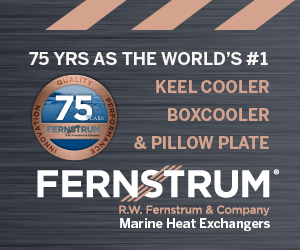Hearing Witnesses Explore Shipbuilding, Workforce Options
New ideas for policies emerged from two key witnesses at the October 28 meeting of the Senate Committee on Commerce, Science and Transportation’s Subcommittee on Coast Guard, Maritime And Fisheries.
Salvatore Mercogliano, Ph.D., is a professor at Campbell University in Buies Creek, N.C. Tuuli Snow is the talent acquisition and engagement manager at Snow & Company, Inc., a shipyard in Seattle, Wash. Both granted interviews following their testimony.
Examining The Jones Act
One topic that Mercogliano focused on in his Senate testimony was the Merchant Marine Act of 1920, more commonly known as the Jones Act, because it assumed the name of its legislative sponsor – Sen. Wesley Livsey Jones, a Republican from Washington. Today, the Jones Act is held by many as the bedrock of U.S. maritime policy. It sets the requirement that U.S. merchant shipping serving between U.S. ports must be on vessels that are American built, American owned and American crewed. For many, the Jones Act is viewed as sacrosanct, a document not to be changed.
In his testimony, Mercogliano suggested that legislators undertake a “careful re-examination of the act – not to repeal it, but to modernize its application.”
Following his testimony, Mercogliano said the Jones Act needs to be looked at in a broader focus. When passed, it set a comprehensive national maritime strategy, addressing a multitude of issues within 32 sections, from international shipping to domestic steamship lines to classification by the American Bureau of Shipping to possession and control of terminal equipment.
The original act, Mercogliano said, added up to a balanced and comprehensive program. Now, more than a century later, he said that balance, that sense of a bigger picture, has faded, and just three sections draw attention these days – one dealing with cabotage, another dealing with the Federal Maritime Commission (FMC) and its oversight and a third dealing with seafarers’ rights.
This has resulted, he said, in “two kinds of bipolar camps: the ones who don’t want to touch the act and those who want to repeal it. And those two groups never can seem to talk in the middle.”
He proposes it would make sense now for policymakers to take a fresh approach, to ask some basic questions about the Jones Act, seeking answers that retain its goals to ensure strong domestic shipping and shipbuilding but introducing new ideas that encourage implementation of 21st century efficiencies and technologies. Those ideas could reinvigorate the big-picture notion of a comprehensive policy by updating or replacing some of the many sections of the act, he said.
He suggested this conversation might include new allowances for foreign components, such as engines and propellers, along with new ways to best direct and coordinate subsidies and economic and tax policies to recharge U.S. shipbuilding.
“We’re using more and more components from overseas for shipbuilding,” Mercogliano said, adding, “I think we should have a serious discussion about what constitutes Jones Act compliance today.”
Reflagging And Investment Help
Mercogliano wants to speed up reflagging, bringing foreign-built ships into the U.S. registry to expand the domestic fleet, thereby making more shipping choices available within domestic markets. He said this should be done with the provision that these reflagged vessels will be replaced by new builds. He noted the risk to this – that it could be viewed as a kind of “bait and switch, that we’re going to reflag ships, but, in reality, we will never see those new ships getting built.” That could happen, he said, but asked, “Why aren’t we at least talking about this set of issues?”
A second major topic for Mercogliano was the size of the U.S. maritime investment market. He told senators that American maritime investments, when added together, are the fourth largest sum of such investments worldwide. In contrast, he noted, “The U.S. has the 23rd largest merchant marine in the world, which tells me that American investors will invest in shipping. They just don’t want to invest in American shipping.”
This discrepancy has sparked considerable discussion within the subcommittee about how to encourage investment in U.S. shipping. In his post-hearing interview, Mercogliano noted that investors go where there is profitability. One idea, he said, might be to create a pool of money for loans that can offer repayment at favorable rates and terms, a pool that would draw investors because of stability, similar to public utility stocks.
He noted that this is a commitment requiring years or perhaps decades. Mercogliano said that an initial focus on brown water tugs and towboats and ferries can be a good starting point, since these vessels will be in service more quickly. This work can help rebuild shipyards more quickly. A stable, long-term demand signal will justify new investments in technology and, critically, new opportunities to rebuild America’s maritime workforce, he said.
“For me, this is national defense beyond guns and naval ships and aircraft,” Mercogliano said.
He added that it is critical for the nation that minerals and ores move efficiently on the Great Lakes, that Mississippi River barge traffic meets demand and that coastal harbors and strategic access channels can meet any challenge.
Rebuilding The Maritime Workforce
In her comments to the subcommittee, Snow, whose family owns and operates one of the last independent boat-building companies in Seattle, emphasized the importance of approaching non-traditional pools of potential employees. She said this approach has been successful, noting that employment at her company has expanded from 30 to more than 100 employees over the past five years.
Workforce recruitment and retention for shipyards is an urgent issue now. New demands to expand America’s maritime sector will make this set of issues even tougher, she said.
In a post-hearing interview, Snow was asked to expand on how she set out on her pathways to find new workers. She noted that her previous roles did not include recruiting, and she said, “I kind of just had to see what worked.”
A first step was to join as many associations and career-related newsletters as possible, she said. She said she accepted all invitations to speak about working for Snow & Company. This included reaching out to resource centers for refugees and immigrants. One move was to invite technical school classes or sessions to visit the Snow shipyard “to see what we do in real time.” She added that visits are much more impactful than just presenting pictures.
Visiting groups often included 15 to 20 people at a time. For larger groups, she teamed up with a neighboring shipyard and created two groups, allowing one to visit Snow and the other to go next door. Then they would switch. This provided additional advantages because one shipyard focused on fabricating vessels and the other on engines and deck systems. A possible employee could learn about being a deckhand or engineer versus more technical work.
Whether a visitor might become an employee depends on the group, she said. Snow doesn’t expect an immediate sign-on or even an extended interest that could be checked within six months from high-school visitors but is “planting a seed,” she said, referring to her Senate testimony in which she said, “I play for the maritime long haul, not just our company. I’m investing in building a better industry, not just a better business.”
Snow said that when she speaks to people at career fairs – which she called the most productive recruitment venue – she sees a great response when she describes the range of opportunities that exist within the maritime sector.
“I think when a lot of people see me at a career fair and see pictures of our boats behind me, they assume that I’m looking for deck hands and captains,” she said. “I really try to underscore how many different careers there are, not just within our business, but in the industry as a whole. We’re a design-build business, so we have a team of naval architects, mechanical engineers, electrical engineers and marine designers that work for us as well, but we also have an HR department and an accounting department. That’s probably the biggest thing I’ve noticed, how people light up when they realize that this is a realistic career path for them.”
When asked about what kind of follow up from the Senate hearing would be most helpful, Snow spoke about the importance and value of the U.S. Maritime Administration’s Small Shipyard grants program, specifically mentioning that a program focus on teaching adults looking for new careers could pay great dividends. This grant money, she said, could help pay for apprenticeships or be used to cover the salaries of production employees, allowing those employees to work as on-the-job teachers.
Snow is optimistic about support for shipbuilding. She said, “You know, regardless of anyone’s political background, this is a very bipartisan subject. Everyone in the Senate hearing room wanted the same thing: more shipbuilding in America.”



